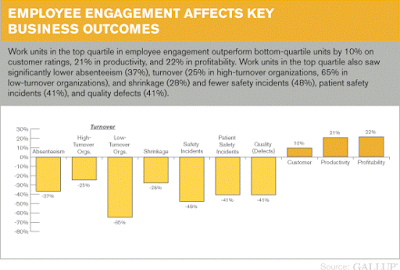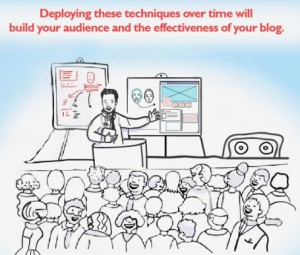
Have you put the spotlight on the employee experience at your company?
I’ve written many times about the importance of the employee experience, both on its own with regard to retention and performance and with regard to the impact of the employee experience on the customer experience.
Sadly, many companies still aren’t focusing on the employee experience. IDC’s 2015 EXPERIENCES Survey work found that 81% of companies listen to customers about their experiences, but 69.4% of companies do not measure the employee experience.
For those still looking for proof that this is a real thing, I’ve started to take note of some recent research and statistics about the impact of a great employee experience. I thought I’d start to compile them in one place and share with you, in case you’re in the process of building the business case or need to nudge your company that employees matter.
It’s important to note that the employee experience starts well before the employee signs on the dotted line. Consider that your candidates may already know the brand through their own interactions as customers; or they may know someone who works – or has worked – for the company.
So let’s start there, with the employer brand. Just as your brand is important to attracting and retaining customers, your employer brand attracts potential employees and drives whether they’ll want to stay. How does your employer brand impact the business? (After all, that’s what executives want to know: if we focus on the employee experience, what does that mean for the business?) Dr. John Sullivan wrote a great article about 10 employer branding business impact metrics that you should track. Pick the ones you want to focus on, but they are listed in order, with the most powerful ones first.
- Better-performing new hires that result from your branding effort
- An increase in overall workforce productivity
- Increased revenue from hires in revenue-generating positions
- A high employee referral rate increases productivity
- A higher employee retention rate of current employees
- A reduced failure rate among new hires
- Your applicants come from top firms
- A higher ratio of winning head-to-head recruiting competitions
- A positive giveaway/takeaway ratio
- Employer branding program ROI
Interesting that he places ROI at the bottom of the list because it seems like that’s where everyone starts! Kevin Kruse defines the ROI or the business impact of employee engagement (which is just one component or measure of the employee experience, along with trust, happiness, satisfaction, retention, etc.) as the Engagement-Profit Chain, which looks like this.
Engaged employees lead to…
- higher service, quality, and productivity, which leads to…
- higher customer satisfaction, which leads to…
- increased sales (from more repeat business and referrals), which leads to…
- higher levels of profit, which leads to…
- higher shareholder returns (i.e., stock price)
Those are pretty powerful outcomes for the business. I don’t think anyone can argue with that. Here’s a graphic that supports that last bullet point about higher shareholder returns. Watermark Consulting looked at the employee experience leaders based on Great Place to Work findings and charted their performance on the S&P 500 for the last 18 years, from 1997 to 2014. Their annualized returns outperformed the stock market by nearly double.

Source: Watermark Consulting
Gallup is, obviously, well known for its employee engagement research. The graphic below depicts some of their findings, with the moral of the story being: those companies in the top quartile in employee engagement outperform those in the bottom quartile on 10 key metrics, including turnover, productivity, customer satisfaction, and profitability.

Aon Hewitt’s 2015 Trends in Global Employee Engagement tells us the following: a 5% increase in employee engagement is linked to a 3% increase in revenue growth in the subsequent year.
In their work, Dale Carnegie Training uncovered that $ 11 billion is lost annually due to employee turnover and that companies with engaged employees outperform those without by up to 202%.
In a report published by PwC, they cited: Based on stock performance, Wharton professor Alex Edmans determined that companies on the Fortune list of “best companies to work for” outperformed their peers by 2–3 percent per year.
In a whitepaper by Rutgers, A New Framework of Employee Engagement, they note that: a meta-analysis of the financial performance of 1,979 business units in ten companies found that business units that score above the database median on both employee and customer engagement metrics were, on average, 3.4 times more effective financially (in terms of total sales and revenue, performance to target, and year-over-year gain in sales and revenues) than units that rank in the bottom half on both measures.
There’s also this Sears work that I’ve cited a few times from a 1998 article in Harvard Business Review; it summarizes the work that Sears executives did to rebuild the company to focus on customers. The article talks about the new business model and what they discovered: “There is a chain of cause and effect running from employee behavior to customer behavior to profits.”
When Sears went through this transformation in the ’90s, they saw some impressive results (according to the same article):
Our model shows that a 5 point improvement in employee attitudes will drive a 1.3 point improvement in customer satisfaction, which in turn will drive a 0.5% improvement in revenue growth.
And…
Independent surveys show that national retail customer satisfaction has fallen for several consecutive years, but in the course of the last 12 months, employee satisfaction on the Sears TPI has risen by 4%, and customer satisfaction by almost 4%. That may seem a trivial improvement. But if our model is correct—and its predictive record is extremely good—that 4% improvement in customer satisfaction translates into more than $ 200 million in additional revenues in the past 12 months. At our current after-tax margin and price-earnings ratio, those extra revenues increase our market capitalization by nearly one-quarter of a billion dollars. Even more impressive from our point of view is what our model tells us: it is our managers and employees who, at the moment of truth in front of the customer, have achieved this prodigious feat of value creation.
I think one of the most disheartening things that I read – though I’m not surprised at all – is that 7 out of 10 companies don’t even measure employee engagement or the employee experience. (But then I also question what the other 3 are doing with what they heard!) That’s insane. It’s really important for companies to understand the impact the employee experience has on the customer experience, on the business, on business outcomes, and more.
Just like with customer experience initiatives, employee experience initiatives and culture transformations and making your company a great place to work happens top-down. If your CEO isn’t committed to the transformation, setting expectations for her managers, and being the role model for how to deliver a great employee experience, it won’t happen. A couple of examples of companies with committed CEOs that come to mind include: Southwest Airlines, Zappos, Amazon, and Barry-Wehmiller.
What about your company? Would you add it to this list of examples? Or is your company part of “that statistic?”
Lots of people know how to manage their business; too few know how to lead their people. -Unknown
(64)







